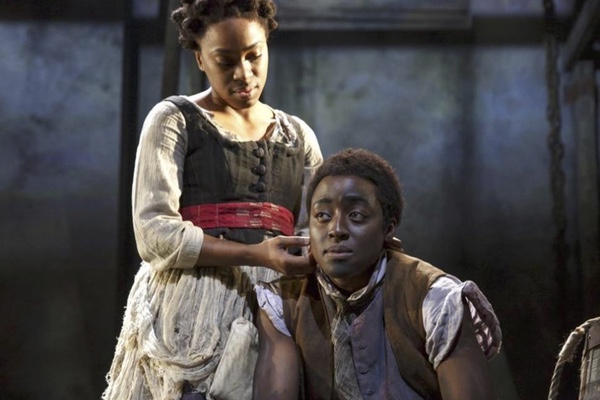Slavery Is Back with a Chill

In Naomi Wallace’s new play Liquid Plain, a slave man, Dembi, and woman, Adjua, runaway lovers from Charleston, are hiding out on a wooden wharf in Bristol, Rhode Island, in 1791 waiting for a ship owned by Quakers to spirit them out of slavery and back to their homes in West Africa. The ship does not come, however, and they are stranded. They save the life of an apparently drowned white sailor suffering from amnesia and then, near the end of the first act, they encounter the captain of the ship that was going to carry them home, sassy, swashbuckling freed black Liverpool Joe. He hatches a plan to get them on to the high seas. They can do it, he tells them.
But can they?
Liquid Plain (I have no idea what the tile means) then leaps ahead 46 years to a sequel, in a way, when Adjua’s attractive, bright daughter, Bristol,, who grew up in England, arrives in Rhode Island, bent on revenge and also bent on finding her father Dembi, believed dead.
The play, that opened yesterday at the Griffin Theater in the Pershing Square Signature Theater on W. 42d Street, in New York, appears to be headed in the right direction when it starts. It is a unique, new look at slavery, escapes and rescues and the people who served in slavery and the people who put them there. But the story gets bogged down rather quickly as the plot veers from right to left. People do things for odd reasons and the mystery in the basic story seems unsolvable.
The play is like a ship that needs a big breeze in its sails.
History lovers will enjoy the play because it presents a lot of little known information about slavery in America. Almost all American slaves who fled their masters went north, to northern U.S. cities or Canada, where slavery was outlawed at the start of the nineteenth century, but in Liquid Plain, they are leaving to return to Africa. The Quakers, an anti-slavery religious group, helped numerous slaves flee their plantations on the Underground Railroad and in 1815 ran a ship from New York to Sierra Leone filled with freed black slaves. In 1820, the American Colonization Society used ships to carry some 15,000 freed slaves to West Africa, where they formed the nation of Liberia. The Society ran out of money, though, and transports stopped. Wallace’s play appears to be based on those travels.
In this play, Adjua and Dembi are not only determined to flee the country, but have a baby that they want to raise as free people in Africa. That plan is threatened by the drowning man they saved, who turns out to be John Cranston, one of the sailors on board the Polly, the ship on which Adjua and her sister sailed to America as captured slaves. Her sister was dumped overboard on the Polly and Cranston was a witness. Here, the story gets very murky.
It gets even murkier when act two begins. It is now 46 years later and Adjua’s daughter Bristol arrives in Bristol, probably in that same wharf, in an effort to find her father, Dembi, and murder the ship’s captain who killed her aunt so long ago in the troubled waters of the South Atlantic. She meets Cranston, now a cranky old bartender, who tells her where the captain, now a Senator, is living.
Then things get bizarre. Bristol meets an old man who seems to be famed poet William Blake, who inhabits the body of a sailor executed and left inside a large metal cage. Odd sounds drift through the theater and a ghost of the long dead aunt walks through the audience (in search of the concession counter, I guess). Bristol, in Bristol, then hunts down the captain, her knife ready for action, searches for her father, flaunts her beautiful British accent and urges peace in the world and freedom for all.
The idea of the play is a good one, but the plot is as soggy as the ocean. The scenes in the story that might have enlivened it, such as the voyage, do not appear on stage and the history of the main characters and their relationship to each other just do not make sense (how on earth does a mongrel slave captain and killer ever get to be a U.S. Senator?)
The play has mechanical problems, too. The staging is too dark. Wallace wanted a dark look for her dark story, but here the lights are nearly out. The names of scenes are projected on to the back wall of the stage, but they are fuzzy and hard to read. The pre-show music, evoking the sea, drones on for too long. However, despite those drawbacks, audiences do learn a lot of behind-the-scenes information about slavery and U.S. history.
Director Kwame Kwei-Armah let the story get away from him. He managed to do a good job of creating a setting and an emotional backdrop through the characters for Wallace’s story, but did not provide the story with the richness it needed. The acting was fine, with Kristolyn Lloyd (Adjua), Ito Aghayeri as Dembi, Michael Izquierdo (Cranston), Karl Miller (Blake), Johnny Ramey (Liverpool Joe), Lisagay Hamilton (Bristol), Lance Roberts (Nesbit), Tuck Milligan (Gifford), Robert Hogan (the Senator), and Tara A. Nicholas (Shadow) playing their parts well.
This is one play about the sea that needs a better boat. It runs through March 29.